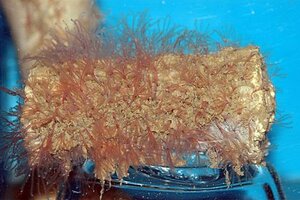Zombie worms eat whale bones — with acid
Zombie worms don't actually drill through bone, as was previously believed. Instead, their skin produces enough acid to dissolve the zombie worms' path through bone.

More than 100 female Osedax, or zombie worms, on the flipper-bone (phalange) of a grey whale collected from the Monterey Submarine Canyon off California.
Martin Tresguerres et al / Proceedings of the Royal Society B / LiveScience.com
So-called zombie worms — and yes, they actually exist — like to munch on whale bones for dinner. The creatures also use the bones for shelter. Spread throughout the world's oceans, zombie worms are quite adept at making the bones of whales and other large marine animals look like Swiss cheese.
But these worms don't have any mouthparts with which to gnaw the holes. So how do they do it? A study published in the May 1 online edition of the journal Proceedings of the Royal Society B found that rather than being "bone-drilling" worms, they're actually "bone-dissolving" worms: The worms’ skin produces acid in large quantities to break down bones.
The acid is produced by proton pumps, protein-containing structures abundant in the front end of the worm's body, said Martin Tresguerres, a marine physiologist at the Scripps Institution of Oceanography in La Jolla, Calif.
'Off the charts'
Tresguerres has studied these acid-secreting structures in many other animals, including sharks and various fish. But he hasn't seen anything like this before. "The amount of proton pumps they have is off the charts," he told OurAmazingPlanet.
The cellular mechanism used to produce the acid is nearly identical to that used in osteoclasts, the human cells that break down bone so that it can be rebuilt. Insight into how the worm dissolves bone could possibly be applied to osteoclasts, Tresguerres said. Human kidneys also contain similar proton pumps involved in processing bodily waste, he added.
Even stranger, Tresguerres said, is that the worms lack digestive systems. The study suggests the acid the worms produce frees collagen and other proteins from the whale bones, but how they are broken down and absorbed by the worms is unclear. Tresguerres, along with co-authors Sigrid Katz and Greg Rouse, think that symbiotic bacteria help the animals digest the food.
The worms were first discovered by Rouse and colleagues in 2002 off the California coast in an underwater valley called the Monterey Submarine Canyon.
There are multiple species of these zombie worms, which belong to the Osedax genus. The worms’ closest relatives, which also lack guts and mouths, inhabit deep-sea hydrothermal vents and rely on a different set of bacteria to allow them to survive in these hot and acidic conditions.
Email Douglas Main or follow him @Douglas_Main. Follow us @OAPlanet, Facebook or Google+. Original article on LiveScience's OurAmazingPlanet.
- Extreme Life on Earth: 8 Bizarre Creatures
- Deep-Sea Creepy-Crawlies: Images of Acorn Worms
- Gallery: Creatures from the Census of Marine Life
Copyright 2013 LiveScience, a TechMediaNetwork company. All rights reserved. This material may not be published, broadcast, rewritten or redistributed.

